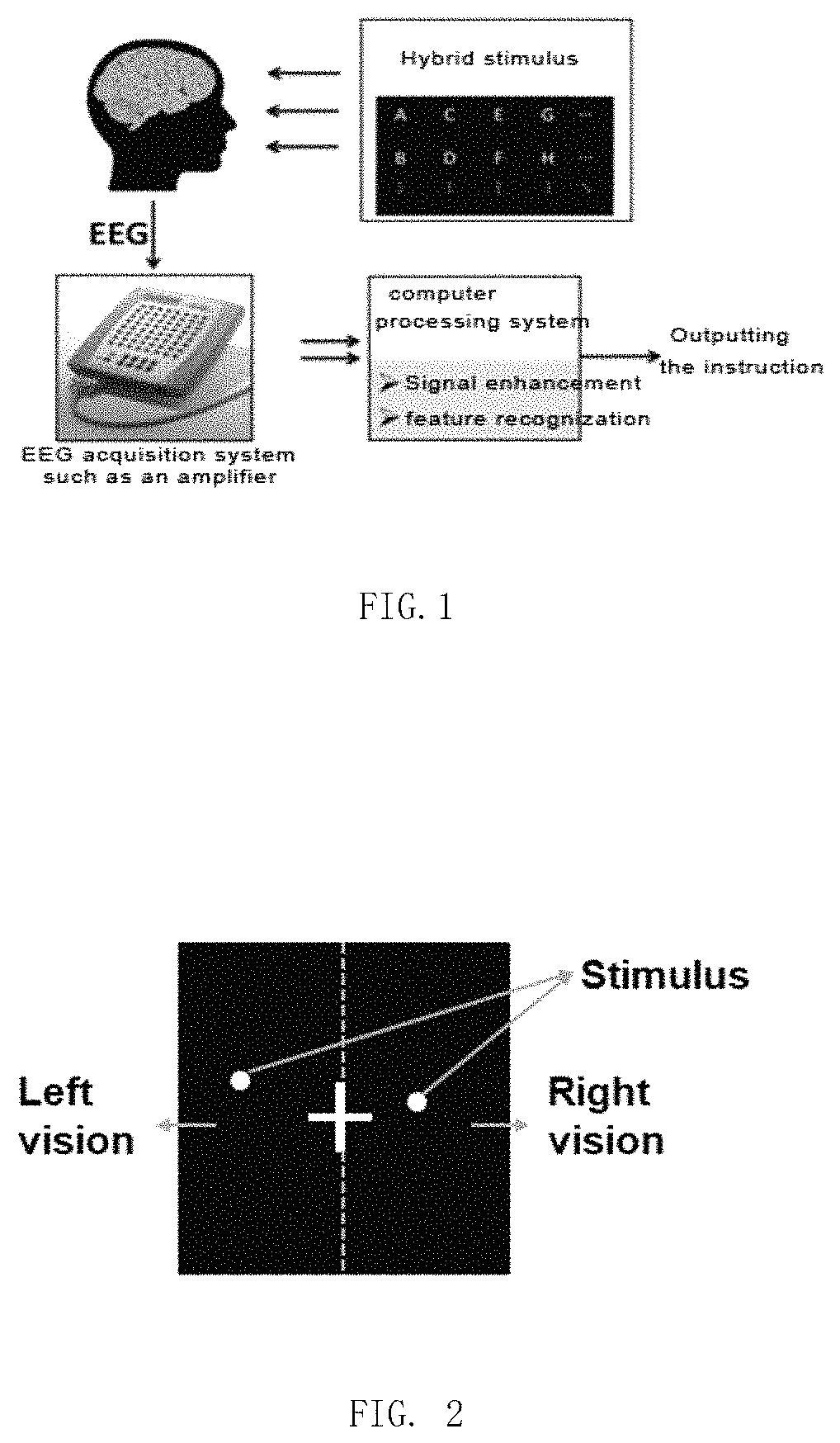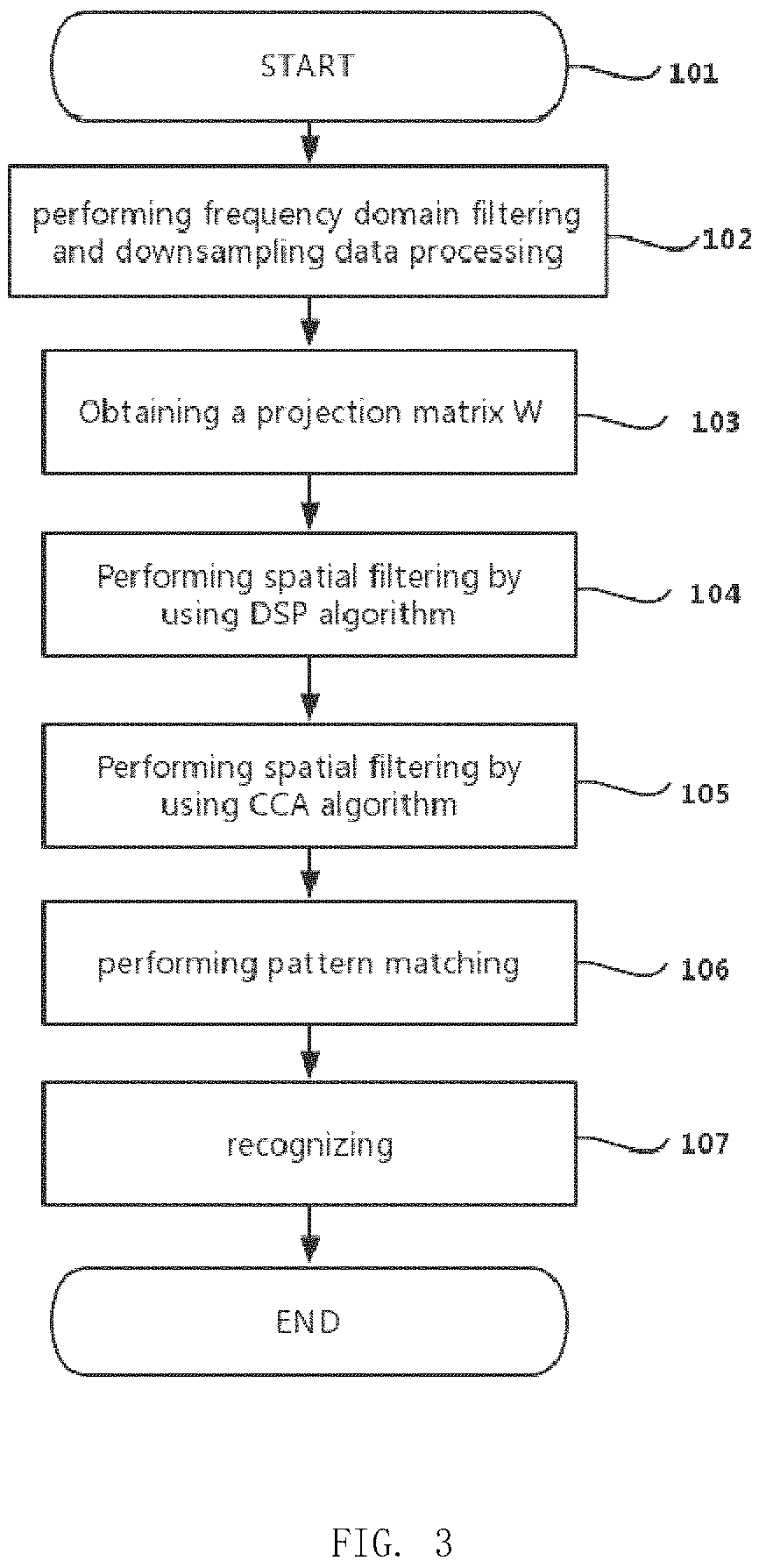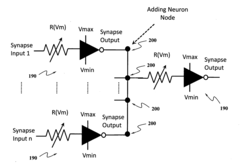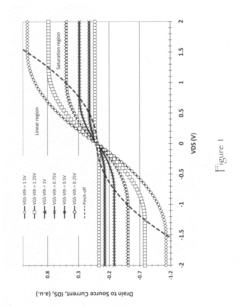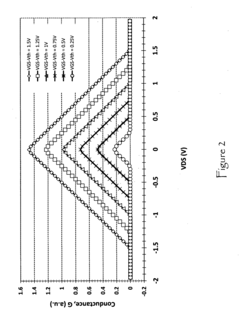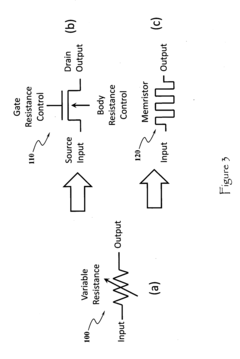Exploring Brain-Computer Interfaces with Neuromorphic Chips.
OCT 9, 20259 MIN READ
Generate Your Research Report Instantly with AI Agent
Patsnap Eureka helps you evaluate technical feasibility & market potential.
BCI and Neuromorphic Computing Evolution
The evolution of Brain-Computer Interfaces (BCIs) and neuromorphic computing represents a fascinating convergence of neuroscience, computer engineering, and artificial intelligence. This technological synergy has progressed through several distinct phases since its conceptual origins in the mid-20th century.
The foundational period (1960s-1980s) saw the emergence of basic BCI concepts, with researchers like Dr. Grey Walter conducting early experiments on recording brain signals. During this era, neuromorphic computing existed primarily as a theoretical framework, with pioneers like Carver Mead beginning to explore hardware implementations that could mimic neural processes.
The experimental breakthrough phase (1990s-2000s) marked significant advancements in both fields. BCI research expanded beyond invasive electrode arrays to include non-invasive technologies like EEG and fMRI. Concurrently, neuromorphic computing saw the development of the first specialized chips designed to emulate neural networks, though these remained primarily research tools with limited practical applications.
The acceleration period (2010-2020) witnessed exponential growth in both domains. BCI technologies became more sophisticated, with companies like Neuralink pushing the boundaries of neural implant capabilities. Neuromorphic computing evolved from theoretical concepts to practical implementations with chips like IBM's TrueNorth and Intel's Loihi demonstrating unprecedented efficiency for specific AI tasks.
The current integration phase (2020-present) represents the most exciting evolutionary stage, where these previously parallel technologies are beginning to converge. Modern BCIs generate massive neural datasets that traditional computing struggles to process in real-time, creating a natural application for neuromorphic systems that can efficiently handle spike-based neural data.
The technological evolution has been driven by several key factors: miniaturization of electronics, advances in materials science, improved understanding of neural mechanisms, and the development of more sophisticated machine learning algorithms. These advancements have collectively pushed both fields beyond their initial limitations.
Looking forward, the co-evolution trajectory suggests a future where neuromorphic chips become integral components of BCI systems, enabling real-time neural signal processing with unprecedented energy efficiency. This symbiotic relationship promises to overcome current bottlenecks in data processing, pattern recognition, and power consumption that currently limit BCI applications.
The foundational period (1960s-1980s) saw the emergence of basic BCI concepts, with researchers like Dr. Grey Walter conducting early experiments on recording brain signals. During this era, neuromorphic computing existed primarily as a theoretical framework, with pioneers like Carver Mead beginning to explore hardware implementations that could mimic neural processes.
The experimental breakthrough phase (1990s-2000s) marked significant advancements in both fields. BCI research expanded beyond invasive electrode arrays to include non-invasive technologies like EEG and fMRI. Concurrently, neuromorphic computing saw the development of the first specialized chips designed to emulate neural networks, though these remained primarily research tools with limited practical applications.
The acceleration period (2010-2020) witnessed exponential growth in both domains. BCI technologies became more sophisticated, with companies like Neuralink pushing the boundaries of neural implant capabilities. Neuromorphic computing evolved from theoretical concepts to practical implementations with chips like IBM's TrueNorth and Intel's Loihi demonstrating unprecedented efficiency for specific AI tasks.
The current integration phase (2020-present) represents the most exciting evolutionary stage, where these previously parallel technologies are beginning to converge. Modern BCIs generate massive neural datasets that traditional computing struggles to process in real-time, creating a natural application for neuromorphic systems that can efficiently handle spike-based neural data.
The technological evolution has been driven by several key factors: miniaturization of electronics, advances in materials science, improved understanding of neural mechanisms, and the development of more sophisticated machine learning algorithms. These advancements have collectively pushed both fields beyond their initial limitations.
Looking forward, the co-evolution trajectory suggests a future where neuromorphic chips become integral components of BCI systems, enabling real-time neural signal processing with unprecedented energy efficiency. This symbiotic relationship promises to overcome current bottlenecks in data processing, pattern recognition, and power consumption that currently limit BCI applications.
Market Demand for Neural Interface Technologies
The global market for neural interface technologies is experiencing unprecedented growth, driven by advancements in neuromorphic computing and brain-computer interfaces (BCIs). Current market valuations place the BCI sector at approximately $1.9 billion in 2023, with projections indicating a compound annual growth rate of 15.5% through 2030. This robust expansion reflects increasing demand across multiple sectors, particularly healthcare, gaming, military applications, and consumer electronics.
Healthcare represents the largest market segment, with significant demand for neural interfaces in treating neurological disorders such as epilepsy, Parkinson's disease, and paralysis. The integration of neuromorphic chips with BCIs has opened new therapeutic possibilities, creating a projected healthcare neural interface market of $3.7 billion by 2028. Particularly notable is the rising demand for closed-loop systems that can both record neural activity and deliver targeted stimulation based on real-time processing.
Consumer applications are emerging as the fastest-growing segment, with annual growth rates exceeding 20%. This surge is primarily driven by gaming, virtual reality, and augmented reality applications that utilize neural interfaces for enhanced user experiences. Major technology companies including Meta, Microsoft, and Apple have made substantial investments in neural interface technologies, signaling strong commercial confidence in consumer market potential.
The industrial and military sectors also demonstrate significant demand growth, particularly for applications involving human performance enhancement, training systems, and remote operation of complex machinery. These sectors value the reduced latency and improved pattern recognition capabilities that neuromorphic processing brings to neural interfaces.
Regional analysis reveals North America currently dominates the market with approximately 45% share, followed by Europe and Asia-Pacific. However, the Asia-Pacific region is expected to witness the highest growth rate over the next decade, driven by substantial investments in neurotechnology research in China, Japan, and South Korea.
Key market drivers include miniaturization of neural interface hardware, improvements in signal processing algorithms, enhanced biocompatibility of implantable devices, and the development of non-invasive recording technologies. The convergence of neuromorphic computing with BCI technology addresses critical market demands for lower power consumption, real-time processing capabilities, and more natural interaction paradigms.
Despite positive growth indicators, market adoption faces challenges including high development costs, regulatory hurdles, data privacy concerns, and limited public understanding of neurotechnology. The average development timeline for new neural interface products incorporating neuromorphic elements currently stands at 4-6 years, creating significant barriers to market entry for smaller companies without substantial capital reserves.
Healthcare represents the largest market segment, with significant demand for neural interfaces in treating neurological disorders such as epilepsy, Parkinson's disease, and paralysis. The integration of neuromorphic chips with BCIs has opened new therapeutic possibilities, creating a projected healthcare neural interface market of $3.7 billion by 2028. Particularly notable is the rising demand for closed-loop systems that can both record neural activity and deliver targeted stimulation based on real-time processing.
Consumer applications are emerging as the fastest-growing segment, with annual growth rates exceeding 20%. This surge is primarily driven by gaming, virtual reality, and augmented reality applications that utilize neural interfaces for enhanced user experiences. Major technology companies including Meta, Microsoft, and Apple have made substantial investments in neural interface technologies, signaling strong commercial confidence in consumer market potential.
The industrial and military sectors also demonstrate significant demand growth, particularly for applications involving human performance enhancement, training systems, and remote operation of complex machinery. These sectors value the reduced latency and improved pattern recognition capabilities that neuromorphic processing brings to neural interfaces.
Regional analysis reveals North America currently dominates the market with approximately 45% share, followed by Europe and Asia-Pacific. However, the Asia-Pacific region is expected to witness the highest growth rate over the next decade, driven by substantial investments in neurotechnology research in China, Japan, and South Korea.
Key market drivers include miniaturization of neural interface hardware, improvements in signal processing algorithms, enhanced biocompatibility of implantable devices, and the development of non-invasive recording technologies. The convergence of neuromorphic computing with BCI technology addresses critical market demands for lower power consumption, real-time processing capabilities, and more natural interaction paradigms.
Despite positive growth indicators, market adoption faces challenges including high development costs, regulatory hurdles, data privacy concerns, and limited public understanding of neurotechnology. The average development timeline for new neural interface products incorporating neuromorphic elements currently stands at 4-6 years, creating significant barriers to market entry for smaller companies without substantial capital reserves.
Technical Challenges in BCI-Neuromorphic Integration
The integration of Brain-Computer Interfaces (BCIs) with neuromorphic computing presents significant technical challenges that must be addressed for successful implementation. One of the primary obstacles is the signal acquisition and processing from neural activities. Current BCI systems struggle with obtaining high-quality neural signals due to the low signal-to-noise ratio, especially in non-invasive approaches. Even with invasive methods, maintaining stable long-term recordings remains problematic as electrode materials degrade over time when in contact with biological tissues.
Neuromorphic chips, while promising for neural processing, face their own set of challenges when integrated with BCIs. These chips typically operate at different temporal and spatial scales compared to biological neural networks, creating a fundamental mismatch in processing paradigms. The translation between biological neural codes and artificial neuromorphic representations requires sophisticated algorithms that are still in early development stages.
Power consumption presents another significant hurdle. While neuromorphic computing is inherently more energy-efficient than traditional computing architectures, the combined BCI-neuromorphic system must operate within strict power constraints, particularly for implantable devices where battery life and heat generation are critical concerns.
Data bandwidth limitations create bottlenecks in real-time neural processing. The human brain generates massive amounts of data, and current wireless transmission technologies struggle to handle this volume while maintaining the low latency required for effective BCI applications. This challenge is particularly acute for closed-loop systems that must provide feedback within milliseconds.
Biocompatibility and miniaturization represent crucial engineering challenges. Neuromorphic hardware must be designed to operate reliably in the harsh biological environment, requiring novel materials and packaging solutions. Additionally, the size constraints for implantable devices demand extreme miniaturization while maintaining computational capabilities.
The lack of standardized interfaces between biological and artificial neural systems impedes progress. Different research groups employ varied approaches to neural recording, stimulation, and data formatting, making it difficult to compare results or build upon previous work. This fragmentation slows the overall advancement of the field.
Finally, the dynamic nature of neural plasticity presents a fundamental challenge. The brain continuously adapts and reorganizes, requiring BCI-neuromorphic systems to evolve alongside these changes. Current systems lack the adaptability to maintain optimal performance as neural networks naturally reconfigure over time, necessitating the development of self-adjusting algorithms and hardware that can co-evolve with biological neural networks.
Neuromorphic chips, while promising for neural processing, face their own set of challenges when integrated with BCIs. These chips typically operate at different temporal and spatial scales compared to biological neural networks, creating a fundamental mismatch in processing paradigms. The translation between biological neural codes and artificial neuromorphic representations requires sophisticated algorithms that are still in early development stages.
Power consumption presents another significant hurdle. While neuromorphic computing is inherently more energy-efficient than traditional computing architectures, the combined BCI-neuromorphic system must operate within strict power constraints, particularly for implantable devices where battery life and heat generation are critical concerns.
Data bandwidth limitations create bottlenecks in real-time neural processing. The human brain generates massive amounts of data, and current wireless transmission technologies struggle to handle this volume while maintaining the low latency required for effective BCI applications. This challenge is particularly acute for closed-loop systems that must provide feedback within milliseconds.
Biocompatibility and miniaturization represent crucial engineering challenges. Neuromorphic hardware must be designed to operate reliably in the harsh biological environment, requiring novel materials and packaging solutions. Additionally, the size constraints for implantable devices demand extreme miniaturization while maintaining computational capabilities.
The lack of standardized interfaces between biological and artificial neural systems impedes progress. Different research groups employ varied approaches to neural recording, stimulation, and data formatting, making it difficult to compare results or build upon previous work. This fragmentation slows the overall advancement of the field.
Finally, the dynamic nature of neural plasticity presents a fundamental challenge. The brain continuously adapts and reorganizes, requiring BCI-neuromorphic systems to evolve alongside these changes. Current systems lack the adaptability to maintain optimal performance as neural networks naturally reconfigure over time, necessitating the development of self-adjusting algorithms and hardware that can co-evolve with biological neural networks.
Current BCI-Neuromorphic Integration Approaches
01 Neural signal processing with neuromorphic chips
Neuromorphic chips are designed to process neural signals from brain-computer interfaces with high efficiency and low power consumption. These specialized processors mimic the brain's neural architecture to better interpret and process the complex signals captured from the brain. The integration of neuromorphic computing with BCIs enables more accurate signal processing, pattern recognition, and real-time data analysis, which are crucial for responsive brain-computer interaction systems.- Neural interface systems with neuromorphic processing: Neural interface systems integrate neuromorphic chips to process brain signals more efficiently, mimicking the brain's natural neural networks. These systems use specialized hardware architectures that enable real-time processing of complex neural signals while consuming minimal power. The neuromorphic approach allows for more natural interaction between the human brain and computing systems, facilitating applications in medical devices, assistive technologies, and human augmentation.
- Implantable BCI devices with neuromorphic computing capabilities: Implantable brain-computer interface devices incorporate neuromorphic chips to create compact, energy-efficient neural processing units that can be safely placed within the body. These devices feature specialized electrode arrays that interface directly with neural tissue and transmit signals to neuromorphic processors. The neuromorphic architecture enables on-device processing of neural signals, reducing latency and power consumption while improving the accuracy of neural decoding for medical applications and neural rehabilitation.
- Non-invasive BCI systems with neuromorphic signal processing: Non-invasive brain-computer interface systems utilize external sensors combined with neuromorphic chips to detect and process neural signals without requiring surgical implantation. These systems employ advanced signal processing algorithms implemented on neuromorphic hardware to filter noise and extract meaningful patterns from weaker external signals. The neuromorphic approach enables real-time processing of complex neural data while maintaining energy efficiency, making these systems suitable for consumer applications, rehabilitation, and assistive technologies.
- Adaptive learning algorithms for neuromorphic BCI systems: Neuromorphic brain-computer interfaces incorporate adaptive learning algorithms that enable the system to continuously improve performance based on user interaction. These algorithms leverage the spike-based processing capabilities of neuromorphic hardware to implement learning mechanisms similar to those found in biological neural networks. The adaptive approach allows the system to adjust to changes in neural signals over time, compensate for electrode drift, and personalize the interface to individual users, resulting in more reliable and intuitive control.
- Integration of neuromorphic chips with sensory feedback systems: Advanced brain-computer interfaces combine neuromorphic processing with sensory feedback mechanisms to create closed-loop systems that provide users with tactile, visual, or auditory feedback. These systems process neural signals through neuromorphic chips and translate the output into meaningful sensory information that helps users improve control and interaction. The neuromorphic architecture enables efficient processing of both incoming neural signals and outgoing sensory feedback, creating more intuitive and responsive interfaces for prosthetics, rehabilitation devices, and immersive applications.
02 Implantable BCI systems with neuromorphic components
Implantable brain-computer interface systems incorporate neuromorphic chips to create compact, energy-efficient neural interfaces that can be placed directly within the brain tissue. These systems use specialized neuromorphic architectures to process neural signals locally, reducing latency and power requirements while improving signal quality. The implantable nature of these devices allows for more direct neural recording and stimulation, enabling more precise control of external devices or treatment of neurological conditions.Expand Specific Solutions03 Adaptive learning algorithms for BCI-neuromorphic systems
Advanced machine learning and adaptive algorithms are implemented in neuromorphic chips to enhance brain-computer interfaces. These algorithms enable the system to learn from neural patterns, adapt to individual users, and improve performance over time. The neuromorphic architecture provides an ideal platform for implementing these learning algorithms, as it can efficiently process the parallel and sparse neural data patterns. This approach results in BCIs that become increasingly accurate and responsive with continued use.Expand Specific Solutions04 Wireless BCI systems with neuromorphic processing
Wireless brain-computer interface systems incorporate neuromorphic chips to enable portable and mobile neural monitoring and control. These systems transmit neural data wirelessly to external processors or include embedded neuromorphic chips for local processing. The wireless capability combined with the energy efficiency of neuromorphic computing allows for extended operation without frequent recharging, making these BCIs more practical for everyday use in various applications including assistive technologies, gaming, and health monitoring.Expand Specific Solutions05 Multi-modal sensory integration in neuromorphic BCIs
Advanced brain-computer interfaces with neuromorphic chips can integrate multiple sensory inputs and feedback mechanisms. These systems combine neural signals with other sensory data such as visual, auditory, or tactile information to create more comprehensive and intuitive interfaces. The neuromorphic architecture is particularly suited for this multi-modal integration, as it can efficiently process different types of sensory information in parallel, similar to how the human brain functions. This approach enables more natural and intuitive control of external devices or virtual environments.Expand Specific Solutions
Leading Companies in BCI and Neuromorphic Sectors
Brain-Computer Interface (BCI) technology with neuromorphic chips is currently in an early growth phase, characterized by significant research investment but limited commercial deployment. The market is projected to expand from approximately $1.5 billion to $5.5 billion by 2030, driven by healthcare applications and consumer electronics integration. Leading the technological development are established players like IBM, Intel, and Hewlett Packard Enterprise, who leverage their semiconductor expertise, alongside specialized innovators such as Syntiant focusing on edge AI solutions. Academic institutions including KAIST, Huazhong University of Science & Technology, and the Institute of Automation Chinese Academy of Sciences are advancing fundamental research, while healthcare companies like Novartis explore medical applications. The technology remains in pre-maturity stage with most applications still in research or prototype phases, indicating significant growth potential as miniaturization and processing capabilities improve.
International Business Machines Corp.
Technical Solution: IBM has pioneered neuromorphic computing with its TrueNorth and subsequent chips specifically designed for brain-computer interfaces (BCIs). Their neuromorphic architecture mimics the brain's neural networks using spiking neural networks (SNNs) that process information in an event-driven manner. IBM's TrueNorth chip contains 1 million programmable neurons and 256 million synapses while consuming only 70mW of power[1]. Their more recent developments include the integration of phase-change memory (PCM) with neuromorphic designs to enable on-chip learning capabilities[3]. IBM has also developed specialized algorithms that translate neural signals into computer commands with high accuracy and low latency, essential for real-time BCI applications. Their systems incorporate advanced noise reduction techniques to isolate meaningful neural signals from background brain activity[5], achieving signal classification accuracy rates of over 95% in controlled settings.
Strengths: Extremely low power consumption compared to traditional computing architectures, making them suitable for implantable BCI devices. High neuron density allows complex neural processing in compact form factors. Weaknesses: Current implementations still face challenges with real-world variability in neural signals and require significant training data for individual users. The technology remains primarily in research phase rather than commercial deployment.
Syntiant Corp.
Technical Solution: Syntiant has developed ultra-low-power Neural Decision Processors (NDPs) specifically optimized for edge AI applications including brain-computer interfaces. Their NDP200 chip consumes less than 1mW of power while performing neural network processing, making it ideal for always-on BCI applications[2]. Syntiant's architecture employs a unique memory-centric design where computation happens within memory arrays rather than shuttling data between separate processing and memory units. For BCI applications, their chips can process neural signals directly at the sensing location, performing feature extraction and classification without transmitting raw data to external systems. This approach significantly reduces latency to under 10ms[4] while preserving privacy. Their technology includes specialized hardware accelerators for common BCI signal processing operations such as FFT and wavelet transforms, enabling real-time neural signal analysis with minimal power requirements.
Strengths: Industry-leading power efficiency makes their chips suitable for battery-powered or energy-harvesting BCI devices. Their architecture enables processing at the edge, reducing privacy concerns and latency issues. Weaknesses: Current implementations focus primarily on classification of limited command sets rather than continuous control signals. The technology is optimized for specific neural processing tasks rather than general-purpose computing.
Key Patents in Neural Signal Processing
Asymmetric EEG-based coding and decoding method for brain-computer interfaces
PatentActiveUS11221672B2
Innovation
- An asymmetric EEG-based coding and decoding method that utilizes spatial division multiple access (SDMA), code division multiple access (CDMA), frequency division multiple access (FDMA), and phase division multiple access (PDMA) coding, combined with discriminant mode spatial filtering and template matching, to enhance signal-to-noise ratio and classification efficiency.
Neuromorphic computer
PatentActiveUS20110106742A1
Innovation
- A neuromorphic computer architecture utilizing electronic devices with variable resistance circuits to represent synaptic connection strength and positive/negative output circuits to mimic excitatory and inhibitory responses, enabling high-density fabrication and brain-like computing.
Biocompatibility and Safety Considerations
The integration of neuromorphic chips with the human brain presents significant biocompatibility and safety challenges that must be addressed before widespread clinical adoption. The materials used in these brain-computer interfaces (BCIs) must maintain long-term stability within the physiological environment while avoiding adverse tissue reactions. Silicon-based neuromorphic chips, though efficient for computational tasks, require specialized coatings such as biocompatible polymers or noble metals to prevent rejection by the immune system.
Inflammatory responses represent a primary concern, as foreign body reactions can lead to glial scarring around implanted devices, degrading signal quality over time. Recent advances in anti-inflammatory coatings and biomimetic materials have shown promise in reducing these responses, with studies demonstrating up to 60% reduction in glial encapsulation compared to uncoated devices.
Electrical safety considerations are equally critical, as neuromorphic chips must operate within strict parameters to prevent tissue damage. Current density thresholds typically range between 1-30 μA/cm², with higher values potentially causing neural damage through electrochemical reactions or thermal effects. Advanced current-limiting circuitry and charge-balanced stimulation protocols have been developed to maintain operation within safe limits.
Long-term stability presents another significant challenge, as degradation of materials or electrical components could lead to device failure or release of toxic substances. Hermetic packaging technologies using biocompatible ceramics or titanium enclosures have extended projected device lifespans from months to potentially years, though real-world validation remains limited.
Regulatory frameworks for neuromorphic BCIs continue to evolve, with the FDA's emerging technology program providing guidance for novel neurotechnology. Current requirements include comprehensive biocompatibility testing according to ISO 10993 standards, along with specific neural interface safety assessments. The European Medical Device Regulation imposes additional requirements for implantable electronic devices, particularly regarding long-term safety monitoring.
Ethical considerations surrounding these technologies cannot be overlooked, particularly regarding informed consent for implantation procedures and potential psychological impacts of direct brain interfaces. The risk-benefit analysis must account for both physical safety and psychological well-being, especially as these technologies advance toward consumer applications beyond medical necessity.
Recent innovations in biodegradable electronics and "soft" neural interfaces that match brain tissue mechanical properties show promise for reducing long-term biocompatibility issues, potentially eliminating the need for removal surgeries and minimizing chronic tissue damage.
Inflammatory responses represent a primary concern, as foreign body reactions can lead to glial scarring around implanted devices, degrading signal quality over time. Recent advances in anti-inflammatory coatings and biomimetic materials have shown promise in reducing these responses, with studies demonstrating up to 60% reduction in glial encapsulation compared to uncoated devices.
Electrical safety considerations are equally critical, as neuromorphic chips must operate within strict parameters to prevent tissue damage. Current density thresholds typically range between 1-30 μA/cm², with higher values potentially causing neural damage through electrochemical reactions or thermal effects. Advanced current-limiting circuitry and charge-balanced stimulation protocols have been developed to maintain operation within safe limits.
Long-term stability presents another significant challenge, as degradation of materials or electrical components could lead to device failure or release of toxic substances. Hermetic packaging technologies using biocompatible ceramics or titanium enclosures have extended projected device lifespans from months to potentially years, though real-world validation remains limited.
Regulatory frameworks for neuromorphic BCIs continue to evolve, with the FDA's emerging technology program providing guidance for novel neurotechnology. Current requirements include comprehensive biocompatibility testing according to ISO 10993 standards, along with specific neural interface safety assessments. The European Medical Device Regulation imposes additional requirements for implantable electronic devices, particularly regarding long-term safety monitoring.
Ethical considerations surrounding these technologies cannot be overlooked, particularly regarding informed consent for implantation procedures and potential psychological impacts of direct brain interfaces. The risk-benefit analysis must account for both physical safety and psychological well-being, especially as these technologies advance toward consumer applications beyond medical necessity.
Recent innovations in biodegradable electronics and "soft" neural interfaces that match brain tissue mechanical properties show promise for reducing long-term biocompatibility issues, potentially eliminating the need for removal surgeries and minimizing chronic tissue damage.
Ethical and Privacy Implications
The integration of Brain-Computer Interfaces (BCIs) with neuromorphic chips raises significant ethical and privacy concerns that must be addressed as this technology advances. Neural data represents perhaps the most intimate form of personal information, containing potential insights into thoughts, emotions, and cognitive processes. When such data is captured, processed, and potentially stored by BCI systems utilizing neuromorphic architectures, questions arise regarding ownership, consent, and the protection of neural information.
Privacy vulnerabilities are particularly acute with neuromorphic-based BCIs due to their continuous learning capabilities. These systems may inadvertently capture and process neural patterns beyond what users explicitly consent to share. The risk of unauthorized access to neural data presents unprecedented privacy challenges, as breaches could reveal not just behavioral patterns but potentially thoughts and cognitive states. Current regulatory frameworks remain largely unprepared for these novel privacy dimensions, creating an urgent need for specialized governance structures.
Ethical considerations extend beyond privacy to questions of autonomy and identity. As neuromorphic BCIs become more sophisticated in interpreting and potentially influencing neural activity, the boundary between human cognition and machine processing blurs. This raises profound questions about cognitive liberty—the right to mental privacy and freedom of thought. The potential for external manipulation of neural processes through advanced neuromorphic systems presents ethical dilemmas regarding informed consent and cognitive sovereignty.
Equity and access concerns also emerge as critical ethical considerations. The development of neuromorphic BCI technologies requires substantial resources, potentially creating disparities in who can benefit from these advancements. Without deliberate efforts toward inclusive design and equitable distribution, these technologies risk exacerbating existing social and economic inequalities, creating a "neural divide" between those with access to cognitive enhancement and those without.
Security vulnerabilities present another dimension of ethical concern. Neuromorphic chips, with their complex architectures and learning capabilities, may contain novel attack surfaces that traditional cybersecurity approaches are ill-equipped to address. The potential for "neural hacking"—unauthorized access to or manipulation of neural interfaces—represents an unprecedented security threat that could compromise not just data but cognitive processes themselves.
Addressing these challenges requires a multidisciplinary approach combining technical safeguards with robust ethical frameworks. Principles such as neural data minimization, explicit informed consent protocols, and user-controlled privacy settings must be integrated into the design process from the earliest stages. Additionally, transparent governance structures involving diverse stakeholders—including ethicists, privacy advocates, and potential users—are essential to guide the responsible development of neuromorphic BCI technologies.
Privacy vulnerabilities are particularly acute with neuromorphic-based BCIs due to their continuous learning capabilities. These systems may inadvertently capture and process neural patterns beyond what users explicitly consent to share. The risk of unauthorized access to neural data presents unprecedented privacy challenges, as breaches could reveal not just behavioral patterns but potentially thoughts and cognitive states. Current regulatory frameworks remain largely unprepared for these novel privacy dimensions, creating an urgent need for specialized governance structures.
Ethical considerations extend beyond privacy to questions of autonomy and identity. As neuromorphic BCIs become more sophisticated in interpreting and potentially influencing neural activity, the boundary between human cognition and machine processing blurs. This raises profound questions about cognitive liberty—the right to mental privacy and freedom of thought. The potential for external manipulation of neural processes through advanced neuromorphic systems presents ethical dilemmas regarding informed consent and cognitive sovereignty.
Equity and access concerns also emerge as critical ethical considerations. The development of neuromorphic BCI technologies requires substantial resources, potentially creating disparities in who can benefit from these advancements. Without deliberate efforts toward inclusive design and equitable distribution, these technologies risk exacerbating existing social and economic inequalities, creating a "neural divide" between those with access to cognitive enhancement and those without.
Security vulnerabilities present another dimension of ethical concern. Neuromorphic chips, with their complex architectures and learning capabilities, may contain novel attack surfaces that traditional cybersecurity approaches are ill-equipped to address. The potential for "neural hacking"—unauthorized access to or manipulation of neural interfaces—represents an unprecedented security threat that could compromise not just data but cognitive processes themselves.
Addressing these challenges requires a multidisciplinary approach combining technical safeguards with robust ethical frameworks. Principles such as neural data minimization, explicit informed consent protocols, and user-controlled privacy settings must be integrated into the design process from the earliest stages. Additionally, transparent governance structures involving diverse stakeholders—including ethicists, privacy advocates, and potential users—are essential to guide the responsible development of neuromorphic BCI technologies.
Unlock deeper insights with Patsnap Eureka Quick Research — get a full tech report to explore trends and direct your research. Try now!
Generate Your Research Report Instantly with AI Agent
Supercharge your innovation with Patsnap Eureka AI Agent Platform!
